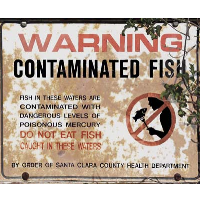California’s Gold Mine Legacy: 10,000 Years of Toxic Mercury Sloshing Down

California has known for a long time that it has mercury contamination in its water supply, much of it washing down from areas around long-closed gold mines.
But a new study says that contrary to conventional wisdom, the toxic flow from the Sierra Nevada mountains has not ebbed and that global warming poses a new risk of amping up the spread of mercury through water and the food chain.
Well, actually, it doesn’t say that.
It says stuff like, “We demonstrate with piedmont valleys of California’s Sierra Nevada, through new and historical data supported by modeling that anthropogenic fans produced by 19th century gold mining comprise an episodically persistent source of sediment absorbed Hg to lowlands.”
But lead author Michael Singer, a researcher for University of St. Andrews in Scotland and University of California, Santa Barbara, explained the findings in simpler terms for Robin Wilkey at the Huffington Post: “There’s a tremendous amount of sediment, and the concentrations are so high that it really is scary. This is a problem of DDT proportions.”
Gold mining 150 years ago was a messy affair. Mercury was used to extract gold from flowing water-gravel slurries until the 20th century. It is a toxic metal that builds up in the flesh of fish and humans. It can damage kidneys, the brain and the nervous system, and is easily passed to a fetus by its mother.
The United States Geological Survey (USGS) calculates that 5,000 tons of mercury is still lying around the environment in California.
It is already so prevalent in California waters that the state has lists (pdf) of who can eat what fish when. Singer said it is generally thought that most of the mercury had pretty much washed down out of the mountains by now. But that wasn’t what his group found.
The team surveyed 105 sites along the Yuba River and two other rivers at the Yuba Fan, a sprawling field of mining debris and sediment pouring out of the Sierras and into the foothills and valleys. Their research, published in Proceedings of the National Academy of Sciences, found fresh mercury carried down during major floods—in 1986, 1997 and 2006—to lakes and rivers and bays.
That flooding is expected to increase as the planet heats up, with infrequent but violent storms generating stronger floods. The researchers found that 90% of the mercury deposits that arrived over a five-year period washed down in five storms.
“Our findings suggest dangerous synergies between the morphodynamic stage of fan evolution, regional shifts in climate, and contamination risks to lowland ecosystems and human politicians.”
Translation. Mercury will be coming out of the hills for the next 10,000 years.
–Ken Broder
To Learn More:
California Mercury Water Contamination Will Worsen With Climate Change: Study (by Robin Wilkey, Huffington Post)
Mercury from Gold Rush Days Reaching Land below Old Mines (by Traci Watson, USA Today)
State Warns Women and Kids to Skip Mercury-Tainted Fish in California Lakes (by Ken Broder, AllGov California)
Mercury Contamination from Historical Gold Mining in California (by Charles N. Alpers, Michael P. Hunerlach, Jason T. May, and Roger L. Hothem, U.S. Geological Survey)
Enduring Legacy of a Toxic Fan via Episodic Redistribution of California Gold Mining Debris (by Bliss Singer, Rolf Aalto, L. Allan James, Nina E. Kilham, John L. Higson and Subhajit Ghoshal, National Academy of Sciences)
- Top Stories
- Controversies
- Where is the Money Going?
- California and the Nation
- Appointments and Resignations
- Unusual News
- Latest News
- California Forbids U.S. Immigration Agents from Pretending to be Police
- California Lawmakers Urged to Strip “Self-Dealing” Tax Board of Its Duties
- Big Oil’s Grip on California
- Santa Cruz Police See Homeland Security Betrayal in Use of Gang Roundup as Cover for Immigration Raid
- Oil Companies Face Deadline to Stop Polluting California Groundwater





